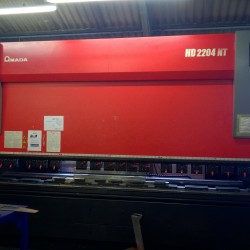Pressing questions about brakes answered
Press brakes are to Castleford based sheet metal and laser cutting firm Yorkshire Laser what bread is to butter.
Maybe so but press brakes come with jargon such up stroking, down stroking, swan neck and hemming so Yorkshire Laser & Fabrications Managing Director Matt Orford realised some explaining was called for.
Press brakes comprise a metal machine that folds metals, pressing angles or sometimes radiuses into metal parts.
One example of a sheet metal press brake job is a steel tray with four sides at 90 degrees.
Now for the tools for the job which include a die block for the material to be pressed into by a punch; these need to be the same size.
These basic ratios act as a rule of thumb:
Material less than Material less than Material from 8mm and above at 10 x material thickness for die size
It’s quite simple to determine the angle needed on the die and punch.
If we were bending our tray with 4 x 90 degree corners an 88’ die and punch would be required so we can press our tray and allow for any spring back in the material. The part may need to be slightly over folded so that when the press releases its pressure the material deforms slightly back to the correct angle.
If however our tray had a 40’ angle on one of the flanges of the tray we would need a 30’ die and matching punch to allow us to form past 90’.
There is a vast array of tooling available although a knife style top tool with a 30’ angle is most commonly deployed to save time swapping from die to die.
However in the case of two flanges returning in the same direction a swan neck is recommended. This allows the first flange to pass through a swan-shaped cut out in the tool.
Most machines are down stroking hydraulic although an increasing number of smaller, electric machines are belt driven. The size of the press brake is determined by its tonnage and length, a typical size being three metres long with 100 tons of pressure to apply max.
Finally we come to crowning which causes the centre point between the two hydraulic rams to deform outwards, causing the centre point to be under folded.
This is usually only problematic on parts that are longer than 500mm. A number of systems are used from spring loaded cut outs in the lower beam to a series of wedges and also small hydraulic rams.
If you require parts pressing but don’t have the facility contact Yorkshire Laser which has over 25 years of press braking experience.
For more information visit www.yorkshirelaser.co.uk

